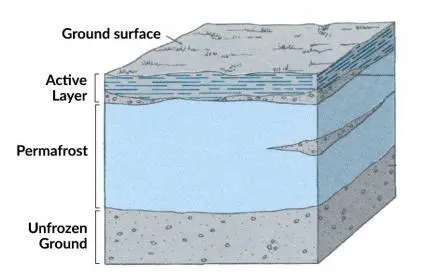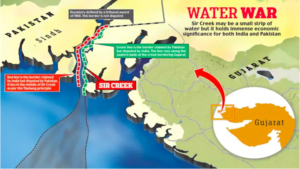Permafrost -UPSC
Introduction
Permafrost, or permanently frozen ground, is one of the most fascinating and important elements of Earth’s cryosphere. It plays a crucial role in climate change, hydrology, and ecosystems in the coldest regions of the world. For UPSC aspirants, understanding permafrost is critical not only for Geography but also for subjects like Environment, Ecology, and Climate Change. This eBook provides an in-depth exploration of permafrost, its significance, distribution, environmental impacts, and its relevance to India and global climate systems.
What is Permafrost?
Definition and Formation
Permafrost is defined as ground that remains at or below 0°C for at least two consecutive years. It typically exists in high-latitude regions such as the Arctic and Antarctic, but it can also be found in high-altitude areas like the Himalayas. The term “permafrost” refers not just to frozen soil but also to frozen rock, organic material, and ice.
Permafrost forms when the heat from the Earth’s surface cannot penetrate deep into the ground, leading to the cooling and freezing of the subsurface layers. This phenomenon usually occurs in areas with extreme cold temperatures, long winters, and minimal warmth during summers.
Types of Permafrost
Continuous Permafrost: Found in the coldest areas, where nearly 100% of the ground is frozen. This type is typical in the Arctic Circle, Siberia, and northern Canada.
Discontinuous Permafrost: Exists in areas where the ground is only partially frozen. There are isolated patches of unfrozen ground amidst the frozen landscape, typical in southern parts of Siberia or northern Europe.
Sporadic Permafrost: Found in areas where permafrost is more scattered, often covering less than 50% of the area. This can occur in high-altitude regions like the Alps and the Himalayas.
Global Distribution of Permafrost
Geographic Distribution
Permafrost occupies nearly 24% of the Northern Hemisphere’s land area. The largest continuous permafrost regions are found in:
- Siberia: The Russian Arctic is home to some of the most extensive permafrost zones on Earth.
- Canada: The northern parts of Canada, particularly in Yukon, Northwest Territories, and Nunavut, are dominated by permafrost.
- Alaska: A significant portion of Alaska’s land is covered by permafrost.
- Greenland: Known for its glaciers, Greenland also has widespread permafrost.
Permafrost in the Southern Hemisphere
Though most permafrost is located in the Northern Hemisphere, it does exist in the Southern Hemisphere, particularly in the Antarctic and parts of the Andes Mountains in South America.
High-Altitude Permafrost
In addition to latitude-based permafrost, high-altitude regions like the Himalayas, the Rockies, and the Andes also experience permafrost due to cold temperatures at high elevations. These regions are crucial as they serve as water reservoirs, feeding major rivers.
Importance of Permafrost
Climate Regulation
Permafrost plays a key role in the Earth’s climate system. It traps vast amounts of organic carbon and greenhouse gases, including carbon dioxide (CO₂) and methane (CH₄), in frozen form. These gases are locked in the soil, preventing them from entering the atmosphere.
When permafrost melts due to global warming, these trapped gases are released, potentially accelerating climate change. This phenomenon is referred to as the “permafrost carbon feedback.”
Hydrology
Permafrost affects local hydrological systems by acting as an impermeable layer that prevents water from draining deep into the soil. This leads to the formation of wetlands, ponds, and lakes in permafrost regions. However, as permafrost thaws, the hydrology of these regions can change drastically, affecting water availability and quality.
Impact on Ecosystems
The unique ecosystems of the Arctic and sub-Arctic regions are dependent on the frozen ground. Thawing permafrost can disrupt these ecosystems, causing shifts in vegetation, habitat loss, and changes in the distribution of species, including Arctic wildlife like reindeer, caribou, and polar bears.
Permafrost and Climate Change
Thawing Permafrost and Global Warming
One of the most critical challenges of climate change is the rapid thawing of permafrost. Scientists estimate that nearly one-third of the world’s permafrost could disappear by the end of the 21st century if global temperatures continue to rise. This could release approximately 1.7 trillion tons of carbon stored in permafrost soils, equivalent to more than twice the amount of carbon currently in the atmosphere.
The release of methane, a potent greenhouse gas, from thawing permafrost is a significant concern. Methane has a much greater impact on global warming than carbon dioxide, and its release could create a vicious cycle of warming, leading to more permafrost melt.
Permafrost and the Carbon Cycle
Permafrost acts as a carbon sink, but as it melts, it could turn into a carbon source. This is particularly concerning in the context of the global carbon budget, which aims to limit the amount of carbon entering the atmosphere to prevent catastrophic climate impacts.
Impacts of Permafrost Thaw
Infrastructure Damage
Thawing permafrost poses serious challenges for infrastructure in Arctic and high-altitude regions. Buildings, roads, pipelines, and other structures are built on frozen ground, and as the permafrost thaws, the ground becomes unstable, leading to subsidence (ground sinking) and structural damage.
Cultural Impacts
Many indigenous communities in Arctic regions rely on frozen landscapes for their way of life. Thawing permafrost threatens traditional hunting, fishing, and reindeer herding practices, leading to cultural and socio-economic impacts.
Health Implications
As permafrost thaws, it can expose ancient pathogens that have been frozen for thousands of years. There have been cases where thawing permafrost has led to the re-emergence of diseases like anthrax, posing a potential health risk to both humans and animals.
Permafrost in India
Permafrost in the Himalayas
India does not have extensive permafrost zones like the Arctic regions, but high-altitude permafrost is found in the Himalayas. These frozen layers play a critical role in regulating the flow of rivers such as the Ganges, Brahmaputra, and Indus, which are fed by glaciers and permafrost.
Climate Change and the Himalayas
The Himalayas are particularly vulnerable to climate change, with rising temperatures leading to glacier melt and permafrost thaw. This has implications for water security in India, Nepal, and Bhutan, as these regions rely on meltwater for agriculture and drinking water.
Mitigation and Adaptation
Monitoring and Research
Global efforts are underway to monitor permafrost thaw using satellite data and field studies. International organizations like the Permafrost Carbon Network are working to better understand how permafrost affects the carbon cycle and climate change.
Technological Solutions
In regions where infrastructure is at risk due to thawing permafrost, innovative engineering solutions are being explored, such as elevating buildings and insulating the ground to slow permafrost thaw. In some cases, geoengineering solutions like refreezing permafrost are being considered to mitigate the effects of climate change.
Conclusion
Permafrost is a critical element of the Earth’s climate system, and its thaw has profound implications for global warming, ecosystems, and human infrastructure. For UPSC aspirants, understanding permafrost is essential not only for Geography but also for topics related to climate change, ecology, and environmental policy. As the world grapples with the impacts of global warming, the study of permafrost will become increasingly important for policymakers and scholars alike.
Key Takeaways for UPSC
- Definition and types of permafrost
- Global distribution of permafrost
- Importance of permafrost in climate regulation and ecosystems
- Impact of permafrost thaw on climate change, infrastructure, and indigenous communities
- Permafrost in India and its significance in the Himalayas
- Mitigation and adaptation strategies for managing permafrost thaw









